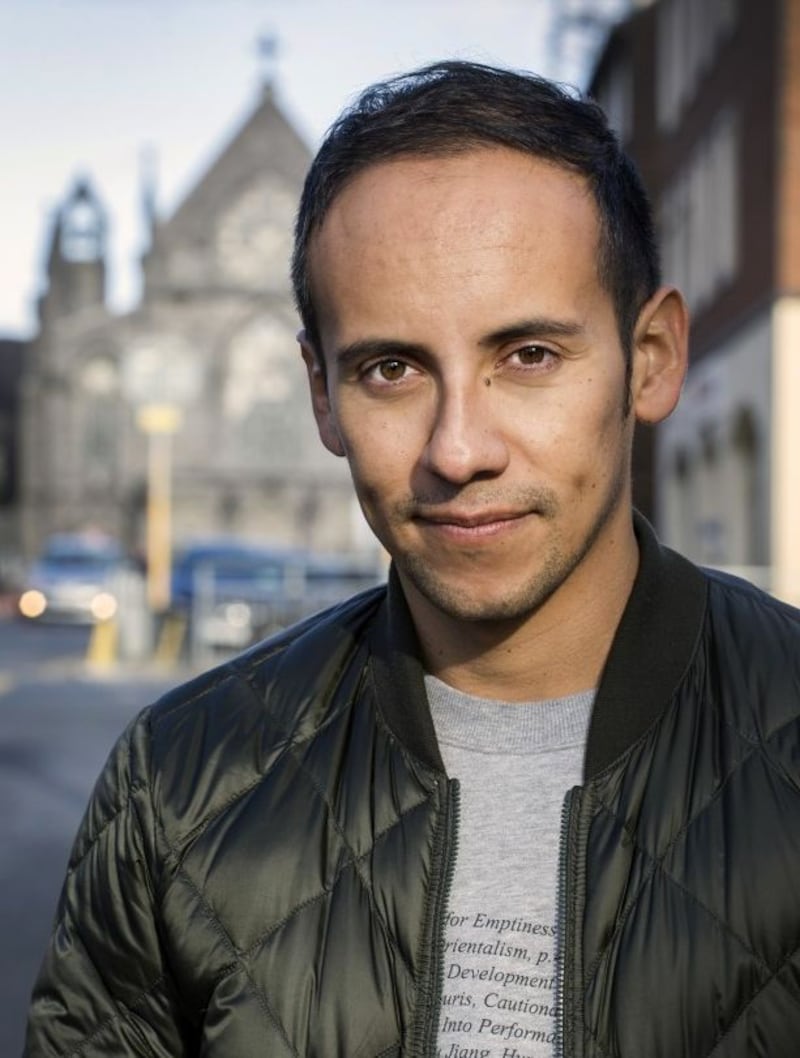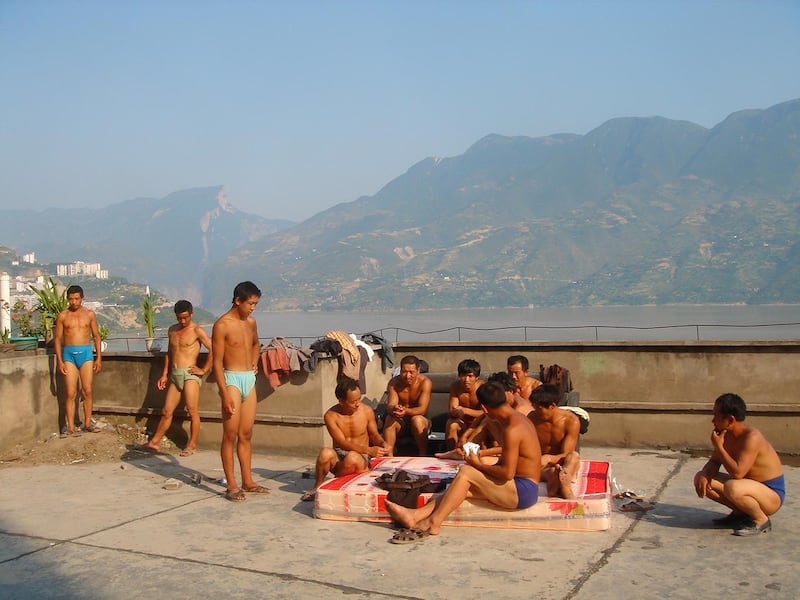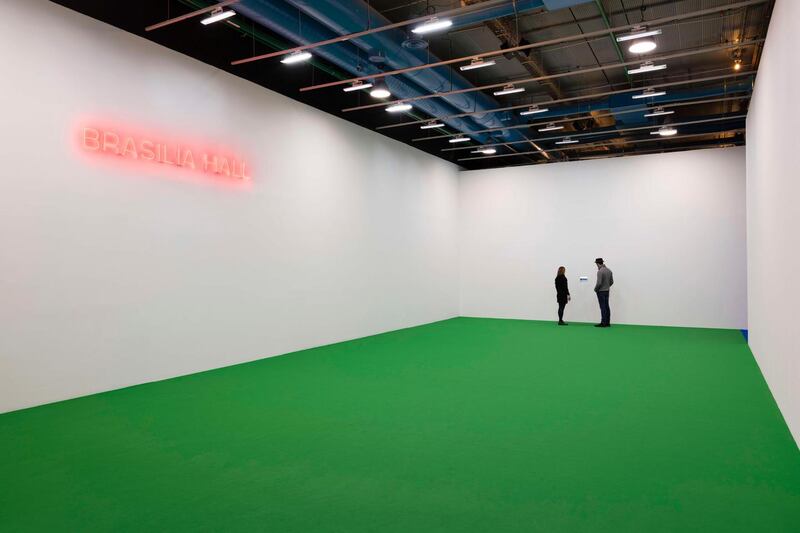When Inti Guerrero, the curator of EVA International 2018, made an exploratory visit to Limerick to get a sense of what kind of exhibition he might make, he had a light-bulb moment when he was in the Hunt Museum. He saw Night's Candles are Burnt Out, one of the paintings Seán Keating made as official artist during the construction of the Ardnacrusha hydroelectric power station, which began in 1925. That moment was the key to his approach to making the exhibition.
For the vast majority of EVA’s curators – a different international figure is invited to curate each time – there’s a balance to be struck between their existing knowledge of the contemporary art world, which is why they are invited in the first place, and acknowledging the context: not just Ireland, but Ireland away from the capital and towards the west.

That usually entails a crash course in Irish history, culture and society. Guerrero, who was born in Bogotá, Colombia and is only in his mid-30s, certainly took that to heart. He has produced an exhibition that is heavily invested in Ireland's post-colonial recent past and contentious present, including Brexit anxieties about the North-South border, and the pending referendum on repealing the Eight Amendment. Night's Candles are Burnt Out is a broad allegory, in Keating's most theatrical manner. In fact, he could be depicting a stage. As a backdrop, the massive concrete earthworks of the damn emerge from the landscape. Across the foreground, an ensemble of Irish types is posed. They include Irish workmen, an enterprising capitalist menaced by a gunman, and a priest studying the bible. The latter, Keating wrote: "represents the unchanging church ever present when spiritual guidance is needed but concerning itself only with a kingdom that is not of this world".
Ardnacrusha was important both symbolically and practically, signalling the fledgling state’s industrial and modernising aspirations and providing most of the country’s electricity supply. It was also a prelude to the massive Rural Electrification Scheme, which followed in the latter half of the 1940s and turned the lights on all over Ireland. Guerrero has put Keating at the heart of EVA. More, art that addresses the construction of hydroelectric dams in various locations throughout the world, and the impact, significance and long-term effects of such schemes, anchor Guerrero’s entire project, which comprises works by 56 artists from 28 countries.
The catalogue is not just an accompaniment to the exhibition, it's part of the exhibition, and rather like a hefty magazine, with widely varied content, including A Short History of Dams and much else. It reprints, for example, Joan Didion's essay on dams from The White Album. She describes how the Hoover Dam, a pivotal initiative for kickstarting the United States post-Depression, and the showpiece of the Boulder Canyon project, imprinted itself indelibly on her mind: "The several million tons of concrete that made the Southwest plausible." She notes the rather naive belief, in retrospect, in the bright promise of engineering at the time.
Elastic definition of the Irish nation
Sorcha O'Brien, whose book Powering the Nation: Images of the Shannon Schemes and Electricity in Ireland, was published last year, contributes an essay that explores the necessarily elastic definition of the Irish nation over the past century and more, the distinctions between nation and state, and the interconnections between infrastructure, cultural identity and state. The state makes the rules, and therein lies a challenge. Whose rules? Artists, curators and all of us, O'Brien argues, are charged with imaginatively shaping a future from these elements.

As infrastructure, dams are conspicuous objects. High profile dams in Egypt and China are among those featured in EVA. Les diables rouges, a painting by Egyptian artist and activist Inji Efflatoun, who died in 1989, represents the vast engineering logistics entailed in the construction of the Aswan High Dam during the 1960s, a flagship for Nassar's Egypt and a positioning of Soviet influence in the region.
One of the most controversial dam constructions ever undertaken, and the largest, the Three Gorges Dam was created on the Yangtze in China in the mid-1990s, displaced well over one million people, flooded many towns and villages, and left a legacy of environmental issues. Painter Liu Xiaodong documented aspects of the process in a huge, five-panel, plein air painting, Hot Bed I, made over the course of a month in 2005, in a way reminiscent of the narrative conventions of traditional Chinese scroll painting.

Guerrero shows documentation of Liu at work on his epic painting, evidencing his involvement with the people whose lives were changed by the advent of the dam.
Other narratives
By no means every artist and every work directly addresses dam construction. "Other narratives that unfold throughout the exhibition," Guerrero explains, "further expand on themes of electricity and light and on metaphors of power." For example, the chandelier recurs as a symbol of Western excess. Colombian artist Gonzalo Fuenmayor's Apocalypse XXI is a photo-realist charcoal drawing of a lighted chandelier hanging from the branch of a banana tree. Fuenmayor's incongruous juxtaposition of bananas and chandelier stems from his exploration of colonialisation and exoticism. The expensive Eurocentric tastes of landlords and overseers in the tropics are set against the commodities produced by the people they exploit.
Guerrero also points to light as symbolizing spirituality in, for example, Mainie Jellett’s synthesis of the dynamics of Cubism – she studied extensively with André Lhóte in Paris – and her own religious faith, expressed through Catholic iconography. Here he also mentions Eileen Gray’s pared down, form-follows-function modernism, and he has included work by both Gray and Jellett in the exhibition.
Not exactly a dam, but certainly a major engineering and architectural utopian project is the subject of French artist Dominique Gonzales-Foerster's installation Brasilia Hall. It's intended as a tribute to urban planner Lúcio Costa and architect Oscar Niemeyer, who designed what was intended to be "Brazil's ideal capital" city, Brasilia, in the late 1950s. Ambiguously, though, her installation is in essence an empty room carpeted in green: shades of Martin Creed's Turner Prize-winning piece which consisted of turning the lights on and off - but Gonzales-Foerster leaves the lights on.

Like Ardnacrusha, Guerrero says, Brasilia was a symbolic statement of modernization. As Gonzales-Foerster sees it, its designers were trying to create a social space as a site of "tolerance and consensus". That dream has not substantially materialized in contemporary Brazil. In the emptiness of her installation, Guerrero interprets not disappointment but the act of opening up a space of potential, "an invitation for the public to create horizons for political imagination", which is not that far from his own overall aim with EVA.
A crucial part of the exhibition
Under the heading of “metaphors of power”, Guerrero regards his invitation to the Artists’ Campaign to Repeal the Eight Amendment to participate as “a crucial part of the exhibition.” The referendum, he notes, takes place during the course of the exhibition. The banners that featured in marches previously will feature in an opening procession. They will then be on display, “together with documentation of previous acts of protest.” Keating’s idealised vision of the Catholic clergy, concerned only “with a kingdom that is not of this world”, did not play out that way in reality.

Several pages of the catalogue are given over to a timeline that extends from the establishment of the first Magdalene laundry on Leeson St in Dublin in 1767 to house "fallen women" through the closure of the last in 1996, to the pending referendum. Among events cites along the way are some landmark advancements in women's right and less happily, some tragedies, including the deaths of Ann Lovett and Savita Halappanavar.
Emer O'Toole's contribution to the catalogue, I Wish Ann Lovett Were Out Buying a Swimsuit for Lanzarote, is a meditation on her own life – her mother was six months pregnant with her when Ann Lovett died – in parallel with accounts of how, like Lovett, "women must suffer for their sexuality in Ireland" – but suffer silently: "We must pretend we're off to London for a fun weekend. We must lie down at the Virgin's feet."
Ardnacrusha, Guerrero suggests, was a beginning rather than an end, part of “a continuous and unfinished process of societal change”, and the exhibition he has shaped reflects both history and the challenges facing contemporary Ireland.
- The 38th EVA International: Ireland's Biennial, Limerick City Gallery of Art, Pery Sq; Cleeve's Condensed Milk Factory, O'Callaghan Strand; The Limerick Clothing Factory, Lord Edward St; The Hunt Museum, Rutland St and other venues. April 14-July 8 eva.ie



















